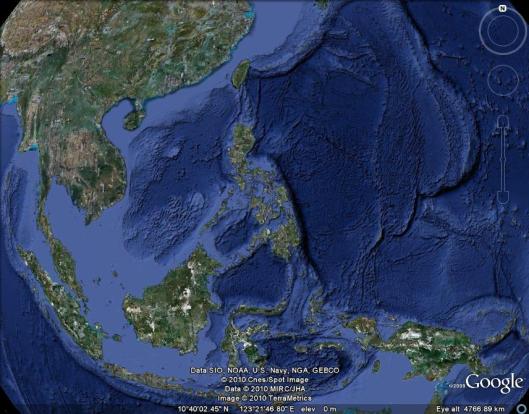Tags
Ever since I can remember, the peopling of the Philippine Islands written in our history books has always been based on American Anthropologist H. Otley Beyer’s theory. After the Negrito, the theory says that there are four waves of migration – Indonesian A, Indodesian B, the Proto-Malays and then the Duetero-Malays. The theory has long been under criticism so one would wonder why other theories were not given the same importance especially when our origin is being taught. (By the way here is an excellent article on these theories from Gaillard and Mallari in Hukay: Jounal of the University of the Philippines Archeological Studies Program.)
One of the theories which is gaining support is proposed by Peter Bellwood. About 6000 years ago according to his theory, people from South China traveled to Taiwan then to the Philippines because of agricultural pressures. Termed as the Out of Taiwan model, it says dispersion of people happened from the north to the south of the Philippines, then to eastern Indonesia, and then to the west (upto Madagascar) and to the east (Polynesian islands).
Kristina A. Tabbada and her co-authors writing in Molecular Biology and Evolution, may have uncovered some clues supporting the Bellwood’s theory as they describe mitochondrial DNA (mtDNA) differences from Philippine samples and investigate these variations with respect to the genetic diversity of other Southeast Asian populations [1].
Here are some of their results (most are written in the authors’ words, hence the quotes).
94% of Philippine samples are part of the mtDNA haplogroups previously identified in East Asian and Southeast Asian populations – subclades of haplogroups B4, B5, D, E, F, R9, M7, Y and M17.
Almost 80% of the mtDNA lineages of the Philippine samples are in common with Taiwanese aboriginal groups and populations of Indonesia (Sulawesi and Austronesian groups in Nusa Tenggara); Other populations in Islands of South EastAsia ISEA (Borneo, Java, Sumatra, and Maluku) have 57–70% in common and 50% or less for Mainland Asia. Fast coastal penetration into the Philippines is unlikely to explain the present day mtDNA variation according to the authors.
There is a a general decrease in HVS-I diversity in the majority of mtDNA haplogroups observed as one goes from Taiwan to the Philippines to Sulawesi. This is consistent with the direction of movement proposed in the Out of Taiwan hypothesis.
The identification of haplogroup B4a1a1 in Philippine samples may indicate a stage of development of the Polynesian Motif that is congruent with the Out of Taiwan hypothesis. The first full Polynesian Motif occurred in Indonesia but the mutation in the Philippines of the B4a1a which came from Taiwan is the precursor of this motif. But the authors also say that back migration from Indonesia may also give this result.
Deeper branches of E1a1 are found within the Taiwanese aboriginal population greater that in the Philippines which reverses the pattern of genetic variation expected if E1a1 expanded from ISEA, if indeed the haplogroup E came from ISEA. E1a1a is found in east New Guinea and Near Oceania. E1a1a with E1b are the only E lineage identified in significant numbers outside of Southeast Asia which may indicate that this haplogroup may have been carried out of ISEA during the expansion of populations into the Pacific.
An identification of a new subclades of haplogroup P in the Philippines. The P subclades were previously thought to be found in numbers in Near Oceania and Australia. The Philippine samples belonging to haplogroup P have HVS-I motifs that are different from those found in Indonesia which means that the haplogroup may have an ancient origin. The estimated founder age of P2 is 47,100 years before present. (This may be our Calloa man.)
There is evidence of substructuring within the lineages which means there is a pattern of long-term in situ evolution. People evolved and diversified separately for a long time in ISEA and the Philippines possibly after the first ancient migration.
K.A. Tabbada and M. C. De Ungria are from the Natural Science Research Institute, UP Diliman. K.A.T is a Chevening scholar at the Leverhulme Centre for Human Evolutionary Studies, University of Cambridge, Cambridge, United Kingdom where Marta Mirazo´n-Lahr and Toomas Kivisild are from. K.A.T. and M.C.A.D.U. acknowledge financial assistance from the Natural Sciences Research Institute and the Office of the Vice Chancellor for Research and Development of the University of the Philippines. J. Trejaut, J. Loo, and M. Lin are from the Transfusion Medicine Research Laboratory, Mackay Memorial Hospital, Taipei, Taiwan while Y. Chen is from the Department of Health, Tainan Hospital, Tainan City, Taiwan
[1] K. Tabbada, J. Trejaut, J. Loo, Y. Chen, M. Lin, M. Mirazon-Lahr, T. Kivisild, and M. C. De Ungria, Philippine Mitochondrial DNA Diversity: A Populated Viaduct between Taiwan and Indonesia? Mol. Biol. Evol. 27(1):21–31 (2010). DOI: 10.1093/molbev/msp215


Pingback: 2010 in review «
Pingback: Y chromosome reveals more about the Filipinos «
Pingback: Why I write about science from the Islands « Imprints of Philippine Science
Pingback: Complete mtDNA genomes of Filipinos reveal recent and ancient lineages | Imprints of Philippine Science
Pingback: Nath’s 30 for 30: 2nd decade’s papers, part 1 | Imprints of Philippine Science
Pingback: Philippine language relations: Reply to comments… | Imprints of Philippine Science
Pingback: Nath’s 30 for 30: 2nd decade’s papers, part 1 – Nouvelles et satellite scientifique